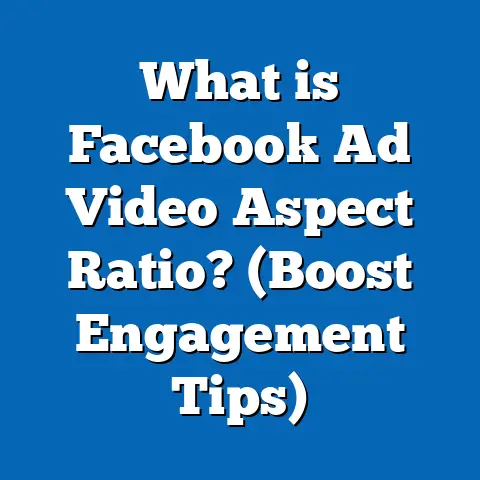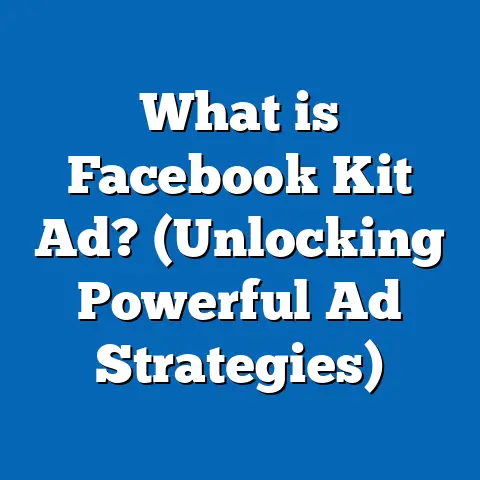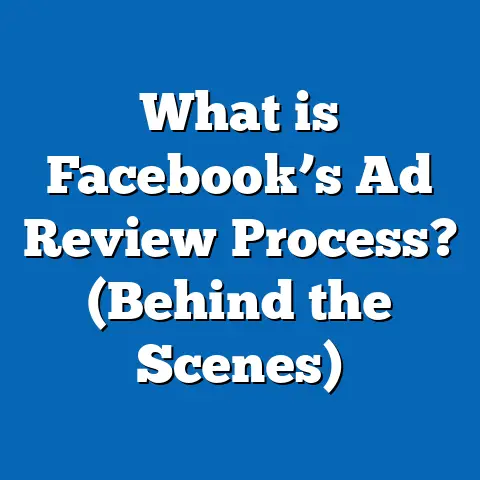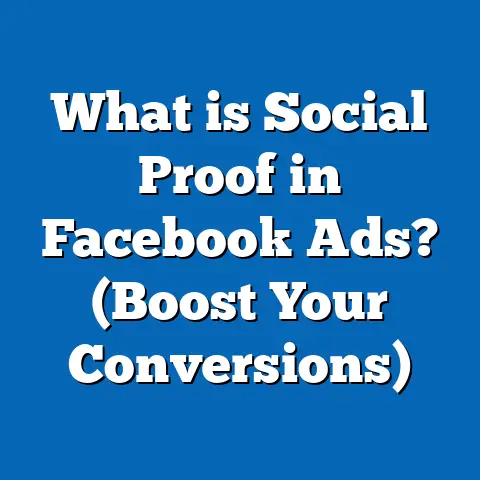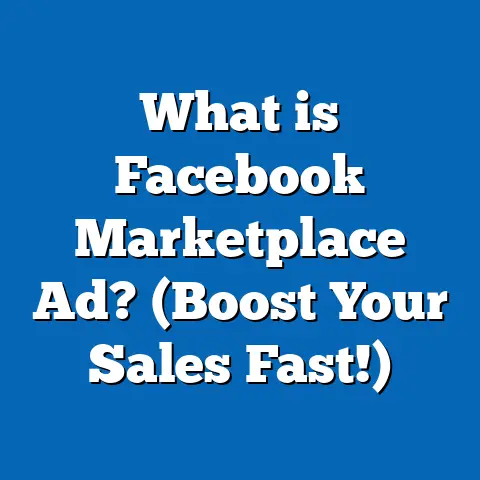What is the Best Facebook Ads Strategy? (Unlock Higher ROI)
Introduction: Future-Proofing Your Facebook Ads Strategy
The digital advertising landscape is evolving at breakneck speed, and brands that want to thrive must future-proof their strategies today. Facebook, with its 3 billion monthly active users as of 2024, remains a dominant force—but success is no longer about simply setting up an ad campaign and hoping for the best. The competition is fierce, consumer expectations are higher than ever, and platform changes are constant. To unlock higher ROI on Facebook ads, you need a strategy that adapts, innovates, and leverages every available advantage.
Why Facebook Ads Still Matter
Unmatched Scale and Targeting Power
- User Base: As of Q1 2024, Facebook boasts over 3 billion active monthly users (Meta earnings report).
- Ad Revenue: In 2023, Facebook generated $131.95 billion in ad revenue (Statista).
- Targeting: With over 50,000 data points per user (The Guardian), Facebook’s ad platform offers granular targeting unmatched by most competitors.
Evolving Consumer Behavior
Mobile usage now accounts for over 98% of Facebook’s access. Video consumption is at an all-time high, with over 140 billion Reels played daily across Facebook and Instagram (Meta Q1 2024).
The Impact of Platform Changes
Recent privacy updates (e.g., iOS 14+) have forced advertisers to rethink data strategies. Yet, brands investing in creative testing, automation, and first-party data collection are seeing higher ROIs than those relying on outdated tactics.
The Foundation: Understanding Facebook’s Advertising Ecosystem
Core Ad Objectives
Facebook’s ad objectives fall into three main categories:
- Awareness: Brand Awareness, Reach
- Consideration: Traffic, Engagement, App Installs, Video Views, Lead Generation, Messages
- Conversion: Conversions, Sales, Store Traffic
Auction Dynamics and Delivery System
Facebook ads operate on an auction system—a blend of bid strategy, estimated action rates, and ad quality. Your CPM (cost per thousand impressions), CTR (click-through rate), and ROAS (return on ad spend) depend on mastering this algorithm.
How the Auction Works
- Bid: What you’re willing to pay for a result.
- Estimated Action Rate: Likelihood the user will take your desired action.
- Ad Quality: User feedback and relevance.
Key Takeaway
Optimizing for relevance and user experience can lower costs by 20–50%, according to Meta’s own research.
Data-Backed Strategies for Higher ROI
1. Creative Testing & Optimization
Why Creative Matters
Ad creative now drives up to 70% of campaign performance variance (Facebook internal studies).
Practical Steps
- A/B Test Creatives: Run at least 3–5 variations per campaign.
- Leverage Video: Ads with video increase purchase intent by 48% over static images (Meta).
- Rotate Frequently: Refresh creative every 2–4 weeks to combat ad fatigue.
Case Study: DTC Skincare Brand
A skincare brand increased ROAS by 2.3x after switching from single-image ads to short-form video testimonials and UGC (user-generated content). Their CPA dropped by 34%, with engagement rates jumping by 52%.
2. Audience Targeting in a Privacy-First Era
Lookalike Audiences & Custom Audiences
- Lookalike Audiences: Average 60% lower CPA compared to broad interest targeting (Facebook data).
- Custom Audiences: Retargeting website visitors can yield a 400% higher conversion rate compared to cold audiences.
New Approaches Post-iOS 14+
- First-Party Data: Collect emails/phone numbers via lead ads or website opt-ins.
- Value-Based Lookalikes: Upload customer value data to focus on high-LTV segments.
Practical Example
An e-commerce store used value-based lookalikes from its top 10% of customers and saw a 36% higher ROAS than standard lookalikes.
3. Automated Campaign Structures: CBO & Advantage+ Shopping Campaigns
Campaign Budget Optimization (CBO)
CBO automatically distributes your budget to top-performing ad sets. Brands using CBO report an average of 15% improvement in CPA vs. manual budget allocation.
Advantage+ Shopping Campaigns
Meta’s AI-driven campaigns use machine learning to optimize placements, bidding, and creative. Early adopters report:
- 40% lower cost per conversion
- 28% higher ROAS (Meta case study compilation)
4. Funnel-Based Strategy: Full-Funnel Approach
Three-Tier Funnel
- Top of Funnel (Awareness): Broad targeting, engaging creatives.
- Middle of Funnel (Consideration): Retargeting video viewers and site visitors.
- Bottom of Funnel (Conversion): Retargeting cart abandoners or high-intent users.
Brands that implement full-funnel strategies see up to 50% higher conversion rates compared to single-stage campaigns (Meta research).
Practical Breakdown
| Funnel Stage | Objective | Example Ad |
|---|---|---|
| TOF | Reach/Brand Awareness | Entertaining videos |
| MOF | Engagement/Traffic | Product demos |
| BOF | Conversions | Dynamic product ads |
Advanced Strategies for Scaling Results
Dynamic Creative & Personalization
Dynamic creative allows Facebook to automatically test combinations of headlines, images, and calls-to-action. Brands using dynamic creative report up to 34% higher conversion rates.
Example: Retail Brand Personalization
A fashion retailer used dynamic product ads with personalized recommendations. This resulted in a 29% lift in average order value (AOV).
Leveraging Facebook Pixel & Conversions API
Facebook Pixel Limitations Post-iOS Updates
Pixel-based tracking has lost accuracy due to privacy changes. Supplement tracking with the Conversions API (CAPI) for direct server-to-server event sharing.
Data Point
Advertisers combining Pixel and CAPI experience an average of 13% more attributed conversions (Meta data).
Creative Automation & AI Tools
AI-powered creative tools can generate hundreds of ad variations in minutes. This enables rapid testing without overloading your creative team.
Measuring Success: Metrics That Matter Most
Key Performance Indicators (KPIs)
- ROAS (Return on Ad Spend)
- CPA (Cost per Acquisition)
- CTR (Click-Through Rate)
- Frequency
- Customer Lifetime Value (LTV)
Focus on blended ROAS across channels rather than last-click attribution for a more accurate view of performance.
Multi-Touch Attribution
Implement multi-touch attribution models using tools like Google Analytics or third-party platforms to understand the true customer journey across devices.
Real-World Case Studies: Proven Results
Case Study #1: B2B SaaS Company
Approach: Used lead ads with educational guides at TOF, retargeted with webinar invites at MOF, closed with demo offers at BOF.
Result: 58% lower cost-per-lead and a 3x increase in qualified pipeline vs. previous campaigns.
Case Study #2: Food Delivery Service
Approach: Switched from static images to short-form Reels optimized for mobile. Leveraged CBO across multiple cities.
Result: Cut acquisition costs by 41%, increased order volume by 72%, with positive feedback from new audiences.
Comparing Facebook Ads to Other Platforms
Facebook vs. Google Ads
| Factor | Facebook Ads | Google Ads |
|---|---|---|
| Intent | Interruption-based | Search/Intent-based |
| Targeting | Demographics/Interests | Keywords |
| Creative | Visual-first | Text + Shopping |
| Avg CPA | $18-$23 ecomm (WordStream) | $45 ecomm avg |
Facebook vs. TikTok Ads
Facebook offers broader age reach and more sophisticated retargeting options; TikTok excels at driving viral engagement among Gen Z but lacks advanced retargeting features.
Practical Implementation: Step-by-Step Blueprint for Success
Step 1: Define Clear Objectives & KPIs
Align campaign goals with business outcomes—brand lift, leads, sales—using SMART goals.
Step 2: Build High-Intent Audiences
Leverage custom audiences from website visitors, email lists, or app users. Use lookalikes for prospecting new customers.
Step 3: Develop Compelling Creative Assets
Invest in video-first content optimized for mobile and short attention spans. Use authentic UGC where possible.
Step 4: Structure Campaigns for Scale
Favor CBO and Advantage+ Shopping Campaigns where appropriate. Maintain a mix of prospecting and retargeting ad sets.
Step 5: Continuously Test and Iterate
Run ongoing A/B tests on creative, audience segments, placements, and bidding strategies. Analyze results weekly.
Step 6: Measure Holistically & Optimize Budget Allocation
Combine platform data with Google Analytics for true attribution. Shift budgets dynamically to highest-performing segments.
Staying Ahead: Latest Trends & Emerging Features in Facebook Ads (2024)
AI-Powered Ad Tools
Facebook is rolling out AI-driven creative suggestions and automated campaign optimizations, reducing manual workload and improving results for early adopters.
Click-to-Messaging Ads Growth
Click-to-Messenger and WhatsApp ads are growing rapidly—usage jumped by over 40% in the past year alone (Meta). These ads drive direct conversations and higher intent leads.
Augmented Reality (AR) Ads
AR ad formats are expanding in retail and beauty sectors—brands using AR try-on campaigns report up to 3x higher engagement rates.
Next Steps & Key Takeaways
- Embrace Creative Testing: Focus resources on diverse video content; refresh often.
- Prioritize First-Party Data: Build robust customer lists and leverage value-based lookalikes.
- Automate Where Possible: Use CBO/Advantage+ Shopping for budget efficiency.
- Adopt Full-Funnel Strategies: Build layered campaigns targeting all stages of the funnel.
- Stay Current: Monitor new features like AR ads and AI-driven optimizations.
- Measure Holistically: Use multi-touch attribution for true ROI clarity.
By implementing these best-in-class strategies—and remaining agile as the platform evolves—you’ll unlock consistently higher ROI from your Facebook ad spend while future-proofing your digital marketing efforts for years to come.


